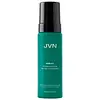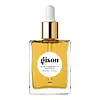What's inside
What's inside
 Key Ingredients
Key Ingredients

No key ingredients
 Benefits
Benefits

 Concerns
Concerns

 Ingredients Side-by-side
Ingredients Side-by-side

Water
Skin ConditioningSodium Polyitaconate
Sorbitan Oleate Decylglucoside Crosspolymer
CleansingSqualane
EmollientHydrogenated Farnesene
EmollientCaffeine
Skin ConditioningGlycerin
HumectantSodium Cocoyl Glycinate
CleansingPanthenol
Skin ConditioningAlthaea Officinalis Root Extract
Skin ConditioningHydroxypropyltrimonium Lemon Protein
HumectantBiotin
AntiseborrhoeicLeuconostoc/Radish Root Ferment Filtrate
AntimicrobialPotassium Sorbate
PreservativeSodium Levulinate
Skin ConditioningMaltodextrin/Vp Copolymer
Sodium Gluconate
Skin ConditioningPhenoxyethanol
PreservativeEthylhexylglycerin
Skin ConditioningSodium Chloride
MaskingCoconut Acid
CleansingGlycine
BufferingSodium Benzoate
MaskingPvp
Emulsion StabilisingCitric Acid
BufferingParfum
MaskingLimonene
PerfumingLinalool
PerfumingWater, Sodium Polyitaconate, Sorbitan Oleate Decylglucoside Crosspolymer, Squalane, Hydrogenated Farnesene, Caffeine, Glycerin, Sodium Cocoyl Glycinate, Panthenol, Althaea Officinalis Root Extract, Hydroxypropyltrimonium Lemon Protein, Biotin, Leuconostoc/Radish Root Ferment Filtrate, Potassium Sorbate, Sodium Levulinate, Maltodextrin/Vp Copolymer, Sodium Gluconate, Phenoxyethanol, Ethylhexylglycerin, Sodium Chloride, Coconut Acid, Glycine, Sodium Benzoate, Pvp, Citric Acid, Parfum, Limonene, Linalool
Dimethicone
EmollientDimethiconol
EmollientTrisiloxane
Skin ConditioningMel
EmollientPrunus Amygdalus Dulcis Oil
Skin ConditioningCocos Nucifera Oil
MaskingArgania Spinosa Kernel Oil
EmollientPassiflora Incarnata Seed Oil
Skin ProtectingTocopheryl Acetate
AntioxidantParfum
MaskingGardenia Taitensis Flower Extract
Skin ConditioningCI 47000
Cosmetic ColorantTocopherol
AntioxidantCI 26100
Cosmetic ColorantCoumarin
PerfumingHexyl Cinnamal
PerfumingLimonene
PerfumingLinalool
Perfuming
 Reviews
Reviews

Ingredients Explained
These ingredients are found in both products.
Ingredients higher up in an ingredient list are typically present in a larger amount.
Limonene is a fragrance that adds scent and taste to a formulation.
It's found in the peel oil of citrus fruits and other plants such as lavender and eucalyptus. The scent of limonene is generally described as "sweet citrus".
Limonene acts as an antioxidant, meaning it helps neutralize free radicals.
When exposed to air, oxidized limonene may sensitize the skin. Because of this, limonene is often avoided by people with sensitive skin.
The term 'fragrance' is not regulated in many countries. In many cases, it is up to the brand to define this term. For instance, many brands choose to label themselves as "fragrance-free" because they are not using synthetic fragrances. However, their products may still contain ingredients such as essential oils that are considered a fragrance.
Learn more about LimoneneLinalool is a fragrance and helps add scent to products. It's derived from common plants such as cinnamon, mint, citrus, and lavender.
Like Limonene, this ingredient oxidizes when exposed to air. Oxidized linalool can cause allergies and skin sensitivity.
This ingredient has a scent that is floral, spicy tropical, and citrus-like.
Learn more about LinaloolParfum is a catch-all term for an ingredient or more that is used to give a scent to products.
Also called "fragrance", this ingredient can be a blend of hundreds of chemicals or plant oils. This means every product with "fragrance" or "parfum" in the ingredients list is a different mixture.
For instance, Habanolide is a proprietary trade name for a specific aroma chemical. When used as a fragrance ingredient in cosmetics, most aroma chemicals fall under the broad labeling category of “FRAGRANCE” or “PARFUM” according to EU and US regulations.
The term 'parfum' or 'fragrance' is not regulated in many countries. In many cases, it is up to the brand to define this term.
For instance, many brands choose to label themselves as "fragrance-free" because they are not using synthetic fragrances. However, their products may still contain ingredients such as essential oils that are considered a fragrance by INCI standards.
One example is Calendula flower extract. Calendula is an essential oil that still imparts a scent or 'fragrance'.
Depending on the blend, the ingredients in the mixture can cause allergies and sensitivities on the skin. Some ingredients that are known EU allergens include linalool and citronellol.
Parfum can also be used to mask or cover an unpleasant scent.
The bottom line is: not all fragrances/parfum/ingredients are created equally. If you are worried about fragrances, we recommend taking a closer look at an ingredient. And of course, we always recommend speaking with a professional.
Learn more about Parfum